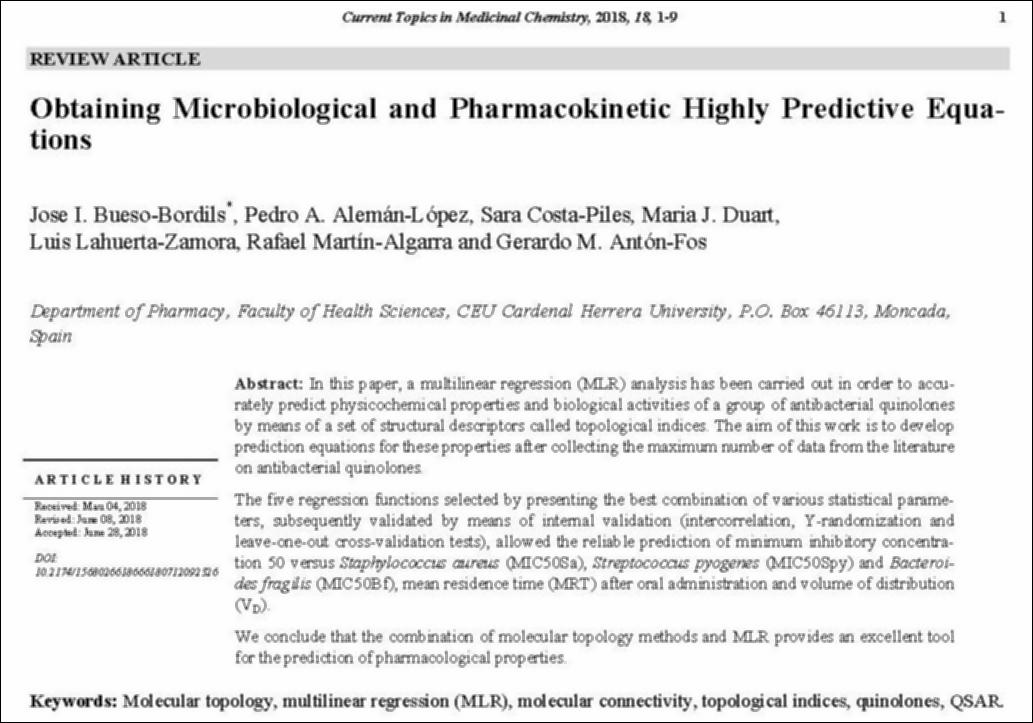Please use this identifier to cite or link to this item:
http://hdl.handle.net/10637/10673Obtaining microbiological and pharmacokinetic highly predictive equations

See/Open:
Obtaining_Bueso_CTMC_2018.jpg
222,43 kB
JPEG
See/Open:
Obtaining_Bueso_CTMC_2018.pdf
Restricted Access
380,71 kB
Adobe PDF
Request a copy
| Title: | Obtaining microbiological and pharmacokinetic highly predictive equations |
| Authors : | Lahuerta Zamora, Luis Martín Algarra, Rafael Vicente Antón Fos, Gerardo Manuel Costa Piles, Sara Bueso Bordils, José Ignacio Alemán López, Pedro Duart Duart, María José |
| Keywords: | Microbiología farmacéutica - Modelos matemáticos.; Farmacología molecular - Modelos matemáticos.; Pharmaceutical microbiology - Mathematical models.; Molecular pharmacology - Mathematical models.; Biología molecular - Modelos matemáticos.; Quinolone antibacterial agents - Mathematical models.; Molecular biology - Mathematical models.; Quinolonas - Modelos matemáticos. |
| Citation: | Bueso-Bordils, J.I., Aleman-López, P.A., Costa-Piles, S., Duart, M.J., Lahuerta-Zamora, L., Martin-Algarra, R., & Anton-Fos, G.M. (2018). Obtaining microbiological and pharmacokinetic highly predictive equations. Current Topics in Medicinal Chemistry, 18(11), 908–916. https://doi.org/10.2174/1568026618666180712092326 |
| Abstract: | In this paper, a multilinear regression (MLR) analysis has been carried out in order to accurately predict physicochemical properties and biological activities of a group of antibacterial quinolones by means of a set of structural descriptors called topological indices. The aim of this work is to develop prediction equations for these properties after collecting the maximum number of data from the literature on antibacterial quinolones. The five regression functions selected by presenting the best combination of various statistical parameters, subsequently validated by means of internal validation (intercorrelation, Y-randomization and leave-one-out cross-validation tests), allowed the reliable prediction of minimum inhibitory concentration 50 versus Staphylococcus aureus (MIC50Sa), Streptococcus pyogenes (MIC50Spy) and Bacteroides fragilis (MIC50Bf), mean residence time (MRT) after oral administration and volume of distribution (VD). We conclude that the combination of molecular topology methods and MLR provides an excellent tool for the prediction of pharmacological properties. |
| Description: | Este artículo se encuentra disponible en la siguiente URL: http://www.eurekaselect.com/163701/article En este artículo también participan Pedro A. Alemán-López, Sara Costa-Piles, María J. Duart, Luis Lahuerta-Zamora, Rafael Martín-Algarra, Gerardo M. Antón-Fos. Este recurso no está disponible en acceso abierto por política de la editorial. |
| URI: | http://hdl.handle.net/10637/10673 |
| ISSN: | 1568-0266 1873-4294 (Electrónico) |
| Issue Date: | Nov-2018 |
| Center : | Universidad Cardenal Herrera-CEU |
| Appears in Collections: | Dpto. Farmacia |
Items in DSpace are protected by copyright, with all rights reserved, unless otherwise indicated.

